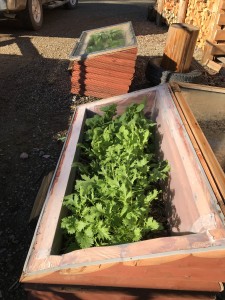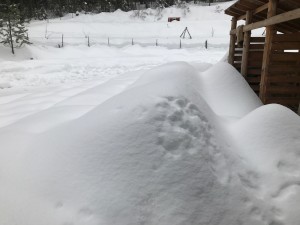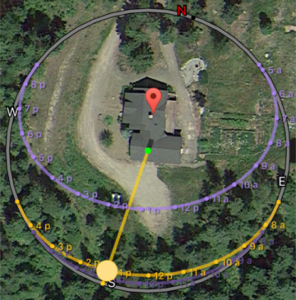
Utilizing cold frames to get an early start and extend the season is one of easiest and most reliable ways to get a jump on the growing season.
Have you ever listened to people talk about building high tunnels and greenhouses? They often are mired in cumbersome grant programs with costs in the thousands and more often in the tens of thousands of dollars. For the small space gardener or self-sufficinet homesteader there is a much better way with the cold frame!
What is a Cold Frame?
A microclimate miracle! Well, not really but it does create a microclimate that gives the grower increased capability. Essentially, a cold frame is a small enclosed space that acts like a greenhouse on a small scale. It creates a microclimate of warmth and protection from snow, ice, frost, wind and critters. It’s often a rectangular box with angled glazing on top facing south.
How Can I Use it?
Cold frames are great for many purposes. The first, which was already mentioned, is protection. The pants in the cold frame are protected from harsh weather. They also are easy to “harden” and prevents critters, whether from below or above, to get at your precious plants! Warning: if you have goats they will stand on top of cold frames if they have access. Control the access or make sure the cold frame is strong enough to handle the occasional goat!

There are Cold Frames under that Snow
Another great use for a cold frame is season extension. There are a lot of factors involving growing season and it depends on the individual situation on how much a cold frame can extend a particular property’s frost free days but it’s very safe to say a cold frame can extend the season AT LEAST a couple of weeks on either side of the growing season.
Cold frames can be used to start seedlings instead of, or in conjunction with, germinating plants indoors under grow lights. Another related use is to take starts that were germinated indoors and use the cold frame to harden off plants in preparation for transplanting. Of course, cold frames are great for production. Having even a small amount of fresh, home grown produce in late fall or even winter is a wonderful treat.
It is not hard to understand that cold frames can be turned into mini “hot houses” to grow crops like tomatoes and peppers in marginal climates. In North Idaho there are wide variations of microclimate that make getting ripe tomatoes and peppers for some people very difficult.
What Types of Plants Should I Grow in a Cold Frame?
Typically you will find cool weather crops growing in cold frames. Very common are lettuces, spinach, kale, cabbage and many types of root crops. That list is not exhaustive but is an indicator of how a family can plan out their food production. As indicated above a cold frame can be used as a “hot house” for warm weather crops as well. For example, if you live in a climate that is difficult to grow cayenne peppers the cold frame could be used to get a jump on the season or used to house the plant through the season. It really depends on your growing goals!
What Types of Materials Can I use to Make a Cold Frame?
A quick search shows that cold frames can be made out of just about anything. Keep in mind that using treated lumber is not recommended unless some kind of barrier is used between the wood and the soil. Straw bales are another common material to use for cold frames. Talk about simple! As far as the glazing is concerned anything from greenhouse plastic remnant to repurposed windows or old shower doors can be used. Another effective material for cold frames is earth! Dig a rectangular hole and cover it and you have a simple cold frame that is using the thermal mass of the earth to help maintain temperature.
Where Should I Place the Cold Frame?
First, you need a south facing area for your cold frame. Use true south as much as possible but don’t worry if you are off a little. In most cases, using magnetic south and then nudging it a bit toward true south works just fine.

Another important aspect is the angle of the glass. Again, don’t get analysis paralysis. The optimal angle depends on the main time of year you plan on using the cold frame. If you are using it year round then a compromise angle like your latitude – 15 degrees might work well. If your main use is going to be late fall, winter and early spring then a steeper angle like your latitude + 10 degrees might be more applicable. For us, the main times of year are fall and spring. We are at 48 degrees of latitude and choose to angle our glass at 35 degrees. This gives us the flexibility to use the cold frame year round although a much steeper angle would be more effective in deep winter.
Finally, it is critical that the cold frame or frames be put in a place that is convenient for the gardener. It should be in sight and in mind. The ideal location is in a “kitchen garden” type location. The ideal place would be right outside your door and in a place where you pass it and/or see it often. For permaculturists this element definitely belongs in zone 1!
Tips and Tricks for Cold Frames
- Make a “hot” compost pile on the bottom to aid in heating the frame during cold weather
- Use a thermal blanket to cover the frames during cold nights
- Cold frames heat up fast, be prepared to regularly vent the frame
- Place a thermometer in the frame to understand what the microclimate is doing
- Avoid treated lumber to construct the frame unless using a barrier of some kind
- Don’t use glazing that is tinted or is meant to reflect light in anyway
Sean and Monica homestead with their family on 40 acres and are using permaculture techniques and methods for the property. The homestead is a demonstration and education site where they teach workshops and raise dairy goats, sheep, pigs, rabbits, chickens, and ducks. The Mitzels have planted food forests, guilds and enjoy wildcrafting and propagating plants. Sean and Monica can often be found speaking and teaching at different events.




Leave a Reply
You must be logged in to post a comment.